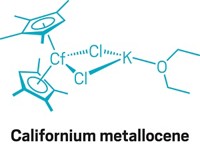Advertisement
Grab your lab coat. Let's get started
Welcome!
Welcome!
Create an account below to get 6 C&EN articles per month, receive newsletters and more - all free.
It seems this is your first time logging in online. Please enter the following information to continue.
As an ACS member you automatically get access to this site. All we need is few more details to create your reading experience.
Not you? Sign in with a different account.
Not you? Sign in with a different account.
ERROR 1
ERROR 1
ERROR 2
ERROR 2
ERROR 2
ERROR 2
ERROR 2
Password and Confirm password must match.
If you have an ACS member number, please enter it here so we can link this account to your membership. (optional)
ERROR 2
ACS values your privacy. By submitting your information, you are gaining access to C&EN and subscribing to our weekly newsletter. We use the information you provide to make your reading experience better, and we will never sell your data to third party members.
Physical Chemistry
ACS Meeting News: Cesium atom coordinates with 16 fluorine atoms in record-setting complex
by Steve Ritter
March 14, 2016

Among the elements, cesium, located in the lower left corner of the periodic table, and fluorine, in the upper right corner, are among the largest electropositive and smallest electronegative elements, respectively. When chemists look at possible ways to get the two elements together, something interesting is bound to happen. And it has.
Klaus-Richard Pörschke, David Pollak, and Richard Goddard of the Max Planck Institute for Coal Research have prepared a molecule in which a central cesium atom is coordinated by 16 fluorine atoms—achieving a perfect score for the maximum number of bonds possible and establishing a new precedent for bonding in the process. Pörschke announced the team’s discovery in a Division of Inorganic Chemistry symposium at the American Chemical Society national meeting yesterday in San Diego.
Going beyond 12 bonds is rare because of the limited space available around the central atom of a molecule and electrostatic repulsion between the ligands. Chemists have flirted with 16-coordinate compounds for years, reporting isolated 15- and 16-coordinate Th-H molecules and a gas-phase 16-coordinate Co-B species.
For Pörschke and coworkers, pairing the large singly charged Cs+ cation with the weakly coordinating [H2NB2(C6F5)6]– anion allowed them to go beyond 12 bonds in a complex for the first time without using hydrogen as a ligand. The team prepared Cs[H2NB2(C6F5)6] by using ultrasound to agitate a solution of [Na(OCH2CH3)4][H2NB2(C6F5)6] and CsF in dichloromethane. The researchers concentrated the solution and isolated crystals to study by X-ray crystallography.
The poor aqueous solubility of the new compound suggested to the researchers that [H2NB2(C6F5)6]– could be a good scavenger of Cs+ in water, which they demonstrated with a set of experiments. Pörschke says that the anion might therefore be useful to pull 134Cs and 137Cs from nuclear waste solutions, as a treatment for 134Cs and 137Cs radiation poisoning, or to prepare implantable 131Cs and 137Cs seeds for radiation therapy.
“Pörschke and coworkers have plumbed the limits of coordination chemistry by a careful matching of cation and anion properties,” commented Warren E. Piers, of the University of Calgary, an expert in coordination chemistry. “In addition to the sheer beauty of the molecule, they demonstrate exciting possibilities for radioactive cesium ion sequestration.”
Other Related Stories:




Join the conversation
Contact the reporter
Submit a Letter to the Editor for publication
Engage with us on Twitter